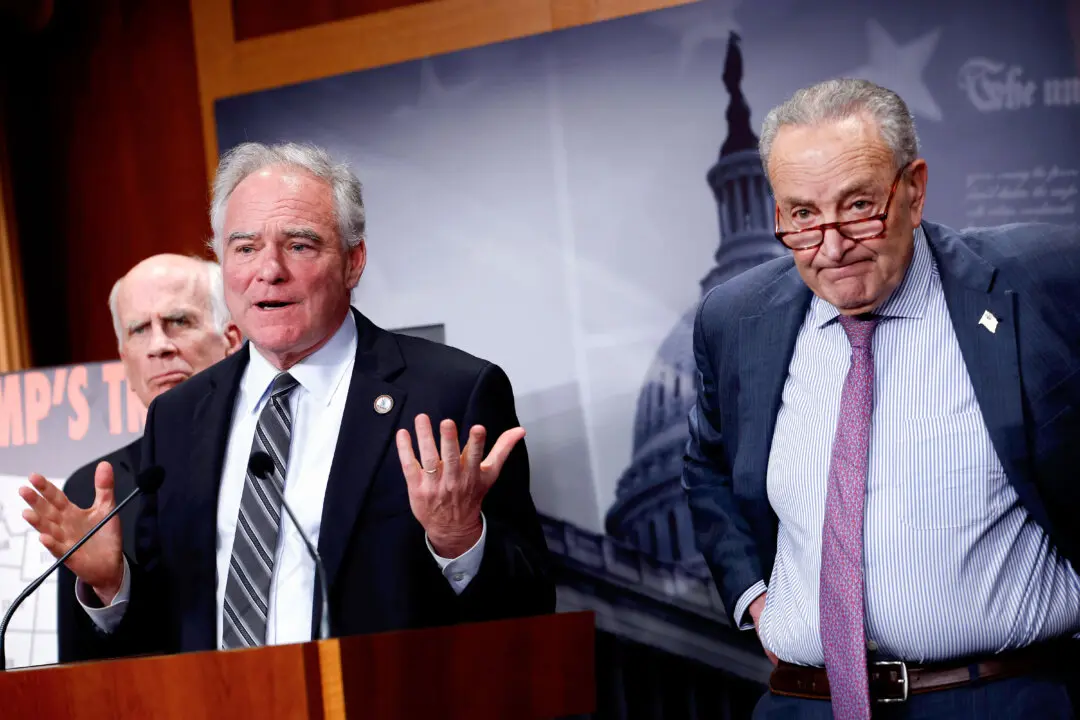WASHINGTON—The U.S. House of Representatives on April 10 approved a budget resolution that is the first step toward enacting President Donald Trump’s legislative agenda, overcoming a substantial procedural hurdle after days of uncertainty.
The resolution had been initially passed by the House on Feb. 25 in a narrow vote of 217–215 and was passed with an amendment by the Senate on April 5. The House concurred with the Senate’s amendment in a narrow vote of 216-214 on April 10. The resolution authorizes relevant committees in both houses of Congress to make recommendations for drafting a final bill, which will then need to be passed by Congress under the “budget reconciliation” process.
The resolution’s passage is a victory for both House Speaker Mike Johnson (R-La.) and Senate Majority Leader John Thune (R-S.D.), who faced resistance with their respective conferences, particularly from fiscal conservatives who opposed its planned spending increases.
“By clearing this critical hurdle, House committees can now work in tandem with Senate committees to swiftly prepare their respective parts of the reconciliation bill, keeping us on track for markups during the next work period,” wrote Johnson in a statement to The Epoch Times. “We will not waver in our commitment to delivering a bill that reduces spending, secures the border, keeps taxes low for families and job creators, [and] restores American energy dominance.”
The resolution’s approval by both houses is only the first step in the reconciliation process.
The final bill is expected to include provisions that extend tax cuts first enacted by the Tax Cuts and Jobs Act (TCJA) of 2017, new funding to construct a wall along the U.S. border with Mexico as well as remove unlawfully present foreign nationals from the country, and increased military spending to counter threats from the Chinese Communist Party, among other initiatives that Trump promised during the 2024 election.
The Reconciliation Process
Republicans are using the reconciliation process to pass the legislation. The process permits budgetary bills to be passed without facing the Senate’s 60-vote cloture requirement that often impedes bills due to a filibuster. Given that Republicans have only 53 members in the Senate, reconciliation is the only way to pass major legislation on party lines without support from Democrats.Because of its immunity from a filibuster, reconciliation has often been used to enact the most major federal legislation in the recent history of the United States. The Health Care Reconciliation Act of 2010, which enacted key provisions of Obamacare, the TCJA of 2017, and, most recently, the American Rescue Plan Act of 2021 and Inflation Reduction Act of 2022, which enacted policies of the Biden administration, were all passed as reconciliation bills.
A reconciliation bill may only include provisions germane to taxation, spending, and public borrowing, which is known in the Senate as the “Byrd Rule.” Pure policy changes that do not have a financial nexus are generally unacceptable. Moreover, any measure that would increase the deficit after 10 years is also unacceptable and must be offset by a corresponding cut to spending.
Drafting the Bill
The passage of the resolution through both houses means that congressional leaders will begin drafting the bill in line with its top-line terms, authorizing several committees to make recommendations for new spending and cuts in the final bill.“The budget resolution … will unlock the ability for the House and Senate to make the Trump tax cuts permanent, reduce wasteful spending, fully fund our border security needs for four years, and provide a needed shot in the arm for the military,” wrote Senate Budget Committee Chairman Lindsey Graham (R-S.C.), who oversaw the drafting of the resolution.
The resolution itself contains the amounts by which spending will be increased, over a 10-year period from 2025 to 2034.
Homeland Security, encompassing immigration enforcement, will gain between $90 billion and $175 billion of new funding that will likely support new detention facilities, overtime pay, and transportation for Immigration and Customs Enforcement (ICE) to execute Trump’s deportation plans targeting illegal immigrants.
U.S. Customs and Border Protection (CBP) will also get new funding for border security, including a potential authorization to move forward with construction of a border wall—Trump’s key promise since his 2016 campaign.
“[Border czar] Tom Homan said ‘I am begging you for money,’” Graham reported at a Feb. 11 press conference. “If you want to track down 300,000 immigrant children who are missing … if you want to finish the wall … if you want a more modern border, we need money to do it,” he added.
The resolution also authorizes around $100 billion and $150 billion in new defense spending. The money is likely to be authorized for new procurement, such as naval vessels, for activities in the Indo-Pacific Region addressing threats from the Chinese Communist Party.
Law enforcement and judicial matters will also see a spending increase of $110 billion to $175 billion. This will be used in part to expedite judicial proceedings for deportees and asylum seekers.
Additionally, the bill will authorize a $4 trillion to $5 trillion debt-limit increase to avert a default by the United States later this year.
Controversies Remain
Most Republicans support the general idea of a large bill to enact conservative priorities. However, the overall cost and offsets have been controversial among many Republicans committed to cutting public spending.The centerpiece of the Senate proposal is a push to make permanent the personal income tax cuts first enacted by the TCJA. These cuts are set to expire on Dec. 31 and will revert to their pre-2017 levels if no action is taken by Congress. The overall extension of the TCJA will be the most expensive item in the bill, costing up to $4.5 trillion.
Yet, in the Senate’s amendment to the budget resolution, merely $4 billion in enforceable spending cuts are ordered. The House’s original instructions, by contrast, called for up to $1.5 trillion in spending cuts—an amount that some Republicans think is still too low.
Fiscal conservatives in Congress claim to have assurances that any tax cuts will be accompanied by corresponding cuts to other areas of spending, and that the final legislation will not increase the deficit.
“I reluctantly voted for the Senate amendment ... on the basis of three specific commitments that form the floor for my consideration of the final reconciliation package,” wrote Rep. Chip Roy (R-Texas), the policy chairman of the House Freedom Caucus, in a statement. The commitments include trillions of dollars of spending cuts to mandatory spending, climate subsidies, Medicaid, and “$1 for $1 tax cuts to spending cuts” in the bill. “Failure to achieve these baselines including deficit neutrality will make it impossible for me to support a final reconciliation product,” he noted.
Rep. Thomas Massie (R-Ky.), by contrast, was the lone Republican in the House to oppose the Senate amendment. “If you were trying to hasten financial collapse of our country and bribe voters to go along with it, the strategy wouldn’t look much different than what Congress is doing today,” he wrote on X. “The big, beautiful bill cuts taxes while keeping spending on an increasingly unsustainable trajectory,” he said.
House Budget Committee Chairman Jodey Arrington (R-Texas), whose committee wrote the House resolution, has also expressed concerns about its potential financial impact.
The budget resolution instructs the House Energy and Commerce Committee to cut $880 billion over a decade, a level that may entail cuts to the Medicaid program, which provides health insurance for low-income persons in cooperation with states. Democrats have heavily criticized this aspect of the plan, while Johnson and GOP leaders have said that only wasteful spending and abuse in the program would be eliminated.
“The budget resolution that passed the House ... will set in motion some of the most extreme cuts to healthcare, nutritional assistance and the things that matter to everyday Americans,” remarked House Minority Leader Hakeem Jeffries (D-N.Y.) at a press conference on April 10, after the bill was passed. He claimed that the bill would entail the “largest Medicaid cut in history.” The program enjoys support from voters across all parties, and it’s unlikely that Democrats in both the Senate and House will vote in favor of any final bill.
Even some Republicans have expressed concerns about cuts to the program—particularly those in battleground districts in states like New York and California. Others, including conservative activist groups, are concerned about a provision in the Senate instructions that could raise the debt ceiling by $5 trillion—a bridge too far for many conservatives.
“This budget sets the stage for the largest deficit increase in history—an unprecedented bill that requires just $4 billion in savings to offset up to $5.8 trillion in deficits. What an absolute disgrace,” wrote the Committee for a Responsible Federal Budget (CRFB), a bipartisan spending watchdog, in a statement.
Republicans have defended their plan by suggesting that high economic growth, resulting from the tax cuts, will offset the deficit. Still, they are working to quickly resolve these differences and produce a final bill soon, as passage of any major legislative package will only get more difficult as the 2026 midterms approach.
“People would be more timid next year than this year, because there'd be an election year. So this is the time,” Rep. Richard McCormick (R-Ga.) told The Epoch Times. “We don’t have another bite at the apple. This is it.”









